|
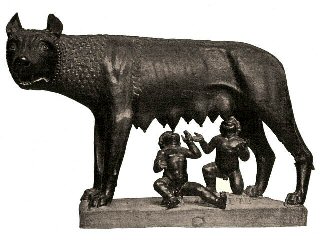
 The Etruscans:
(Tyrrhenians)
The Etruscans:
(Tyrrhenians)
The Etruscan
civilization is the modern English name given to the ancient Italian
civilisation in the area corresponding roughly to Tuscany
(Apparently composed of 12 cities). The ancient Romans who followed
them historically, called its creators the Tusci or
Etrusci.
The Etruscan
civilisation, as distinguished by
its unique language, endured at least from the
time of the earliest Etruscan inscriptions (c. 700 BC) until its
assimilation into the Roman Republic in the 1st century BC
(1)
|
The
Origin of the Etruscans: |
The origin of the
Etruscans has been a subject of debate since antiquity.
Herodotus (c. 430 BC) said for
example that the Etruscans came from Lydia, in Asia Minor, as
the result of a famine around 1,200 B.C,
establishing
themselves over the native inhabitants of the region
(Histories 1.94),
whereas Dionysius of
Halicarnassus (c. 30 B.C.) quoted an earlier historian,
Hellanicus (contemporary of Herodotus), who objected to the
Lydian origin theory on the basis of differences between Lydian
and Etruscan languages and institutions. For Hellanicus, the
Etruscans were Pelasgian's from the Aegean.
Dionysius (Roman antiquities 1.30.2) himself believed
that the Etruscans were of local Italian origin.
Recent DNA research appears to
show that at least part of the Etruscan population was related
to people in Asia Minor (4),
similar DNA tests on goats and cattle suggest Herodotus may have
been the more correct of the three.
(3)
Herodotus: 'Histories', 1.94:
'The Lydians have very nearly the same customs as the
Hellenes, with the exception that these last do not bring up
their girls the same way. So far as we have any knowledge,
the Lydians were the first to introduce the use of gold and
silver coin, and the first who sold good retail. They claim
also the invention of all the games which are common to them
with the Hellenes. These they declare that they invented
about the time when they colonized Tyrrhenia [i.e.,
Etruria], an event of which they give the following account.
In the days of Atys the son of Manes, there was great
scarcity through the whole land of Lydia. For some time the
Lydians bore the affliction patiently, but finding that it
did not pass away, they set to work to devise remedies for
the evil. Various expedients were discovered by various
persons: dice, knuckle-bones, and ball, and all such games
were invented, except checkers, the invention of which they
do not claim as theirs. The plan adopted against the famine
was to engage in games one day so entirely as not to feel
any craving for food, and the next day to eat and abstain
from games. In this way they passed eighteen years.
Still the affliction continued,
and even became worse. So the king determined to divide the
nation in half, and to make the two portions draw lots, the
one to stay, the other to leave the land. He would continue
to reign over those whose lot it should be to remain behind;
the emigrants should have his son Tyrrhenus for their
leader. The lot was cast, and they who had to emigrate went
down to Smyrna, and built themselves ships, in which, after
they had put on board all needful stores, they sailed away
in search of new homes and better sustenance. After sailing
past many countries, they came to Umbria, where they built
cities for themselves, and fixed their residence. Their
former name of Lydians they laid aside, and called
themselves after the name of the king's son, who led the
colony, Tyrrhenians'.
(Article: Feb, 2007. The Telegraph:
Genes Prove Herodotus Right)
The Decline of the Etruscans
By around 500 BC,
Rome had become the most important city on the central Italian
mainland. This allowed it to shrug off its masters, the
Etruscans, who worked for so long to make Rome what it was.
After losing control of Rome to the south, they strengthened
their naval power through an alliance with Carthage against
Greece. In 474 BC their fleet was destroyed by the Greeks of
Syracuse. From that time their power rapidly declined. The Gauls'
overran the country from the north, and the Etruscans' strong
southern fortress of Veii fell to Rome after a ten-year siege
(396 BC), following which the Etruscans were absorbed by the
Romans, who adopted many of their advanced arts, their customs,
and their institutions.
The end of the
Etruscan civilisation is dated at 54 AD. The same year that
Emperor Claudius, the great lover of the Etruscan civilisation
and husband of the Etruscan princess Urgulanilla died. Claudius
was supposedly the last speaker of the ancient language and used
his access to the private libraries to write 20 books entitled "Tyrrhenika"
on the history of the Etruscan people (now lost).
Contemporary reports from
Greeks and Romans tell us that the Etruscans were an educated
people with a range of literature, including religious and
historic texts. Sadly, as was the
case with the Mayan codices, almost all the literature was burnt
by the Romans.
There is evidence that a significant portion of
Etruscan literature was systematically destroyed following the
Theodosian code, since it represented the Old Religion and was
considered as idolatry and the work of the devil. (It is recorded
that Flavius Stilicho, a regent for the Emperor Honorius between 394
and 408 CE, burnt a number of "Pagan volumes" which included the
Tagetic books, which had been stored in the Temple of Apollo in
Rome.) However there are other probable reasons that led to the
demise of Etruscan literature. The question of the scope of Etruscan
literature remains unanswered, but it is quite clear from other
sources that it must have been quite substantial. Censorinus refers
to the Annals of Etruria, and during the late Roman Republic and
Early Imperial years it was considered quite fashionable for Roman
Patricians to send their boys to Etruscan schools to further their
education. Some of this would no doubt have been a grounding in the
disciplina etrusca, but it seems unlikely that that was all that
they learned. We also know that enough of the history of Etruria
survived in written form even up to late Imperial times for the
emperor Claudius to write his twenty volume history of Etruria.
(2)
Regardless of this, a corpus of over 10,000 known Etruscan
inscriptions remain, with new ones being discovered each year. These
are mainly short funerary or dedicatory inscriptions, found on
funerary urns, in tombs or on objects dedicated in sanctuaries.
Others are found on engraved bronze Etruscan mirrors, where they
label mythological figures or give the name of the owner, and on
coins, dice, and pottery. Finally, there are graffiti scratched on
pottery; though their function is little understood, they seem to
include owners' names as well as numbers, abbreviations, and non
alphabetic signs.
Although we know the sounds of the
letters, we do not understand the words.
Archaic Etruscan: (7th - 5th centuries BC)

Neo-Etruscan: (4th-3rd centuries BC).

Examples of
Etruscan Texts.

The longest
surviving Etruscan text today: The 'Liber Linteus'
In 1848 or 1849, a
nobleman from Slovenia, Mihail de Baric, bought a mummy in Egypt,
which found its way into the National Museum of Zagreb in 1862.
Where the mummy had been found and sold is unknown. The mummy
consisted of the remains of a child. It was wrapped in a piece of
linen cloth, which had been torn into wrapping binds. The linen
cloth had been written on with texts in ink, apparently before it
was torn into pieces and used as mummy wrapping. At first it was
thought that the texts were a literal transcription from a text in
Egyptian. In 1891, the Austrian Egyptologist J. Krall discovered
that the linen consisted of Etruscan text.
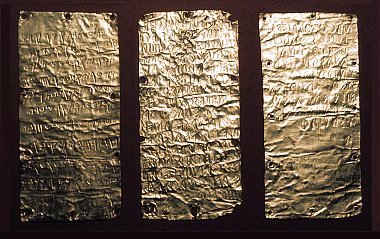
These Gold plates
(The Pyrgi Lamellae) were written in both Etruscan and Phoenician.
They record a dedication to the Goddess called Astarte.
Etruscan Metallurgy.
Etruscan metalwork was highly regarded and
imported by the Greeks and north Europeans. Several elaborate bronze
pieces (tripods, bronze mirrors, cauldrons, pails and wine jugs),
dating from the seventh to fifth centuries BC, have been found in
many locations, including England and Scandinavia.
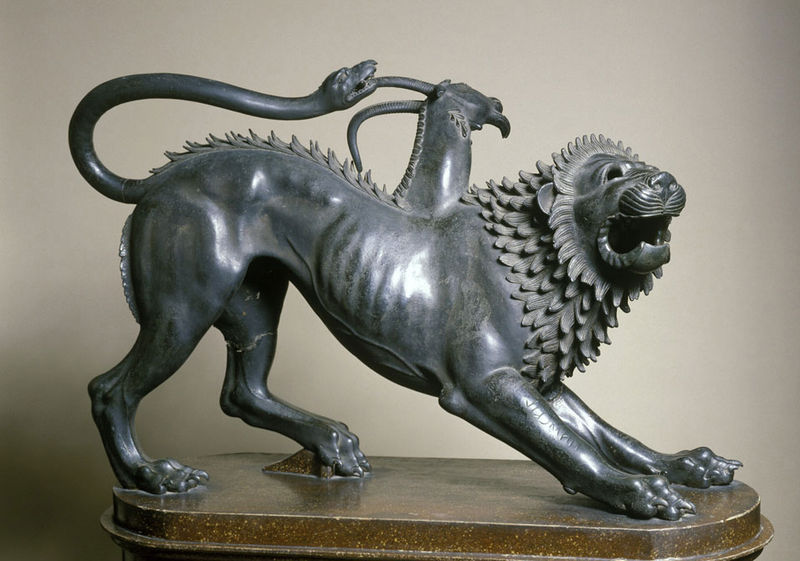
The Chimaera from
Arezzo (C. 500 BC).
Other surviving examples of Etruscan metal sculpture include a
sheet-hammered bust of a woman from Vulci (circa 600 BC), a
charioteer from Monteleone (circa 540 BC), the Apollo of Veii (circa 600 BC), a war god (circa
450 BC) and the Warrior (circa 350 BC). The Capitpline Wolf, the
symbol of Rome, is also believed to be Etruscan, dating from about
500 BC.
(More examples of Prehistoric Metallurgy)
The Afterlife: Tomb Building.
The importance of the afterlife to the
Etruscans is best illustrated in the valley of
Cervtari, Etruscan tombs
can be found. Within it lies the Necropolis Della Banditacca,
The necropolis is a city of the dead. On either side of a "main
street" some 2km/1.5miles long, with a number of side streets, lie
hundreds of tombs, including huge tumuli up to 30m/99ft in diameter
and many tomb chambers hewn from the rock in the form of
dwelling-houses, often with several rooms, with frescoes like the
Tomb of Rilievi decorated with plaster relief's of mythological
figures.
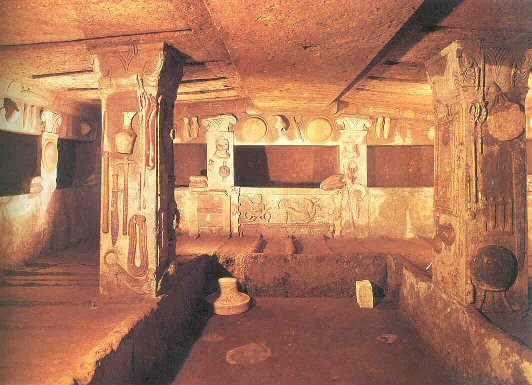
The tombs at Tarquinia and Cerveteri
are particularly interesting because they are of the chamber type: a
large mound would be piled on top of a circular wall with an
entrance to it. The entrance would often lead downwards into a
passageway and into a number of chambers, rather like a house. The
one in the image below is particularly well known for the large
number of relief sculptures showing the different types of
implements and tools one would have had in one's own home at the
time. This tomb is also interesting for the ceiling, which has
obviously been sculpted to mimic the ceiling of housing of the time.
Divination:
Etruscan priests made sacrifices to the gods and
practiced haruspicy (hetacoscopy), or the art of divining the will
of the gods by observing the livers of sacrificed animals, the
patterns of lightning, and the flight of birds. All their methods of
divination were carefully followed by the Romans for centuries
after.

Chalchas the
seer, divining a liver on a bronze (5th cent BC) Etruscan mirror. His
wings and feet demonstrating the symbolic connection of seers
between men and the gods.
(Vatican: Gregorian Museum, Rome, cat #
12240)
The Etruscan discipline of divining
from liver inspection shows remarkably
close correspondence to the form of divination developed in
Mesopotamia and this can best be explained as the transmission of a
�school� from Babylon to Etruria. The correspondence between
Etruscan and Assyrian hepatoscopy is evident when one compares the
Etruscan bronze liver found at Piacenza with the Mesopotamian clay
models (see below). The system on the slaughter of sheep, the models of sheep
livers from clay and metal and the custom of providing them with
inscriptions for the sake of explanation, is something peculiar
found precisely along the corridor from the Euphrates via Syria and
Cyprus to Etruria. It can even be shown that both the Assyrian and
the Etruscan models diverge from nature in a similar way; that is,
they are derived not directly from observation but from common
traditional lore. Models of livers are the concrete archaeological
evidence for the diffusion of Mesopotamian hepatoscopy. Besides
Mesopotamia such models have been found since the Bronze Age with
the Hittites of Asia Minor; in Alalah, Tell el Hajj, and Ugarit in
Syria; in Hazor and Megiddo in Palestine; and also on Cyprus.
Assyrian hepatoscopy was practiced at Tarsus in Cilicia in the time
of the Assyrians.
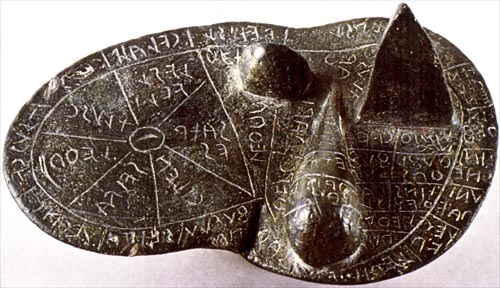
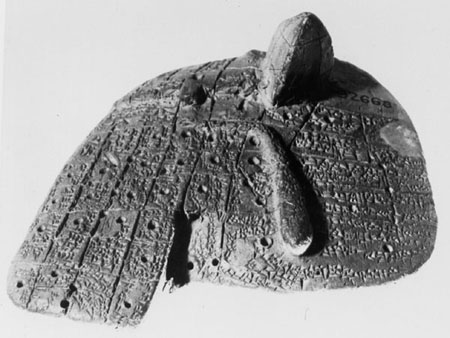
(Left) Etruscan bronze liver found at Piacenza.
(Right) Babylonian 19th Cent. B.C. clay liver (British Museum)
(More about Divination)
Article:
(Sept, 2012) NewsDiscovery.com:
'First Ever
Etruscan Pyramids Found in Italy'.
(Quick-link)
Archaeologists have started clearing an underground
pyramid-shaped vault, the top part of which has been used as a
wine cellar in recent times. As they cleared away the top part,
a series of tunnels, again of Etruscan construction, ran
underneath the wine cellar hinting to the possibility of deeper
undiscovered structures below. Beneath the cellar floor, they
found 6th and 5th century B.C. Etruscan pottery with
inscriptions as well as various objects that dated to before
1000 B.C. Digging through this layer, the archaeologists found 5
feet of gray sterile fill, which was intentionally deposited
from a hole in the top of the structure.
"Below that
material there was a brown layer that we are
currently excavating. Intriguingly, the
stone carved stairs run down the wall as we
continue digging. We still don't know where
they are going to take us," The material
from the deepest level reached so far (the
archaeologists have pushed down about 10
feet) dates to around the middle of the
fifth century B.C. "At this level we found a
tunnel running to another pyramidal
structure and dating from before the 5th
century B.C. which adds to the mystery,"
'The lead archaeologists are
still perplexed as to the
function of the structure
though it is clearly not a
cistern. Dr. Bizzarri notes
that there is nothing like
these structures on record
anywhere in Italy or the
Etruscan world. Dr. George,
notes that it could be part
of a sanctuary, and calls
attention to the pyramid
structures that were
described in the literary
sources as being part of
Lars Porsena�s tomb [1].
Lars Porsena was an Etruscan
king who ruled Chiusi and
Orvieto at the end of the
6th century. Dr. Bizzarri is
however cautious that even
this parallel is not exactly
what is beginning to appear
here, but it does open up
intriguing possibilities.
Both agree that the answer
waits at the base level
which could be 4, 5 or more
metres below the layer they
have now reached'.
(Other
Underground Structures)
(Prehistoric
Italy Homepage)
(A-Z
Pages)
|









